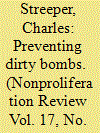| Srl | Item |
| 1 |
ID:
099518


|
|
|
|
|
| Publication |
2010.
|
| Summary/Abstract |
Radioactive sealed sources have a long history and a much wider worldwide distribution than do weapons-usable fissile materials. This article compares the mechanisms for controlling radioactive sources with those of weapons-usable materials and makes the case for improved policy making on the safe and secure management of radioactive sources (often referred to simply as "sources"). Such sources have been widely distributed with commercial and government support to nearly every country, yet there are no legally binding, international agreements or regulations to control any aspect of their life cycle. This is problematic because some sources that are disused, abandoned, or otherwise fall out of regulatory control could be used in the form of a radiological dispersal device (RDD, or dirty bomb). An RDD could pose significant economic and psychological impacts with the potential for detrimental effects on public health. The lack of international measures to control sources is troubling for several reasons: creating an RDD is much easier than fashioning a nuclear weapon from scratch or from stolen fissile materials; given the many incidents involving diversion from regulatory control and the misuse of sources, an RDD attack would be one of the more likely scenarios; materials security for sources is generally weak and inconsistent; it is nearly impossible to determine the total amount of sources manufactured and distributed; used sources are frequently found uncontrolled and transiting borders, and penalties are light at best; the market-based supply and demand of sources facilitates their rapid and loosely regulated distribution; and the "peaceful uses" aspect of the Treaty on the Non-Proliferation of Nuclear Weapons along with norms that began developing around the time of Atoms for Peace have promoted the nearly unchecked global distribution of sources. Several immediate and long-term actions are suggested to reduce the threat posed by radiological sources.
|
|
|
|
|
|
|
|
|
|
|
|
|
|
|
|
| 2 |
ID:
099520


|
|
|
|
|
| Publication |
2010.
|
| Summary/Abstract |
The current nuclear nonproliferation order is no longer sustainable. The Treaty on the Non-Proliferation of Nuclear Weapons (NPT) has weakened considerably over the years, with nuclear have-nots displaying increased dissatisfaction with the status quo. Meanwhile, demands for civilian nuclear technology have led to increased proliferation risks in the form of dual-use technologies. Arms control as we currently understand it-piecemeal treaties and agreements-is no longer sufficient to address the growing threat of proliferation and the frailty of the NPT. This article calls for a bolder nonproliferation agenda pursuing multilateral nuclear disarmament. Disarmament is, in fact, technologically achievable; a lack of political will stands as the only remaining roadblock to a world free of nuclear weapons. A better understanding of the technological feasibility of disarmament, as well as recognition of the diminishing strategic value of nuclear weapons, will help to erode this political reluctance.
|
|
|
|
|
|
|
|
|
|
|
|
|
|
|
|